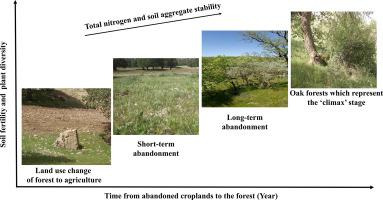当前位置:
X-MOL 学术
›
Ecol. Eng.
›
论文详情
Our official English website, www.x-mol.net, welcomes your
feedback! (Note: you will need to create a separate account there.)
Rapid recovery of the vegetation diversity and soil fertility after cropland abandonment in a semiarid oak ecosystem: An approach based on plant functional groups
Ecological Engineering ( IF 3.9 ) Pub Date : 2020-08-01 , DOI: 10.1016/j.ecoleng.2020.105963 Mehdi Heydari , Nasim Zeynali , Masoud Bazgir , Reza Omidipour , Mehrdad Kohzadian , R. Sagar , Bernard Prevosto
Ecological Engineering ( IF 3.9 ) Pub Date : 2020-08-01 , DOI: 10.1016/j.ecoleng.2020.105963 Mehdi Heydari , Nasim Zeynali , Masoud Bazgir , Reza Omidipour , Mehrdad Kohzadian , R. Sagar , Bernard Prevosto

|
Abstract In many parts of the world, including the semi-arid Mediterranean areas, land abandonment has led to significant changes in vegetation composition, plant diversity as well as soil fertility. In this study, new approaches were presented on how the understory plant functional group diversity and composition changed after land abandonment in Zagros oak forests (Quercus brantii Lindl.) in western Iran. In addition, the impact of land-use change on main soil properties were investigated. The diversity and nutrient status of the three stages of the secondary succession of abandoned agroforestry systems were compared: croplands after a short period of abandonment (~5 years), croplands after a long period of abandonment (~15 years) and oak forests representing the ‘climax’ stage. The plant species were classified in four functional groups (annual forb, annual grass, perennial forb, and perennial grass). The diversity indices were computed for each group and each stage. Results showed that the Shannon-Wiener diversity and Margalef richness of all functional groups significantly increased with time from the shortly abandoned croplands to the forest. Shortly after abandonment, annuals (especially annual forbs) were dominant whereas the abundance of the perennials increased after 15 years of abandonment and in the ‘climax’ forest. The soil content in lime decreased along the successional stages (from 52.7% to 26.4%) and was strongly negatively correlated with the diversity of the perennial forbs. In contrast, the soil total nitrogen and aggregate stability increased with succession (respectively from 0.04% to 0.19% and from 0.49 mm to 0.92 mm) and were strongly positively correlated with the diversity of this group. Recovery in soil fertility (and in particular, total nitrogen), provided suitable conditions for the establishment of a wide range of plant functional groups, which in turn increased the species diversity. The relatively fast recovery of soil fertility and plant diversity of abandoned agricultural lands indicated that the reestablishment of the forest vegetation could rely mostly on natural processes.
中文翻译:

半干旱橡树生态系统农田弃耕后植被多样性和土壤肥力的快速恢复:一种基于植物功能群的方法
摘要 在世界许多地区,包括地中海半干旱地区,土地废弃导致植被组成、植物多样性和土壤肥力发生显着变化。在这项研究中,提出了有关伊朗西部扎格罗斯橡树林 (Quercus brantii Lindl.) 土地废弃后林下植物功能群多样性和组成如何变化的新方法。此外,还研究了土地利用变化对主要土壤性质的影响。比较了废弃农林复合系统次生演替三个阶段的多样性和养分状况:短期废弃(~5 年)后的农田、长期废弃(~15 年)后的农田和代表“高潮”阶段。植物种类分为四个功能组(一年生草本植物、一年生草本植物、多年生草本植物和多年生草本植物)。计算每个组和每个阶段的多样性指数。结果表明,从不久废弃的农田到森林,所有功能群的Shannon-Wiener多样性和Margalef丰富度随时间显着增加。废弃后不久,一年生植物(尤其是一年生杂草)占主导地位,而在废弃 15 年后和“高潮”森林中,多年生植物的丰度增加。石灰中的土壤含量沿着演替阶段下降(从 52.7% 到 26.4%),并且与多年生杂草的多样性呈强烈负相关。相比之下,土壤总氮和团聚体稳定性随着演替而增加(分别从 0.04% 到 0.19% 和从 0. 49 毫米到 0.92 毫米)并且与该组的多样性呈强正相关。土壤肥力(尤其是总氮)的恢复为建立广泛的植物功能群提供了合适的条件,从而增加了物种的多样性。废弃农田的土壤肥力和植物多样性恢复较快,表明森林植被的恢复主要依靠自然过程。
更新日期:2020-08-01
中文翻译:

半干旱橡树生态系统农田弃耕后植被多样性和土壤肥力的快速恢复:一种基于植物功能群的方法
摘要 在世界许多地区,包括地中海半干旱地区,土地废弃导致植被组成、植物多样性和土壤肥力发生显着变化。在这项研究中,提出了有关伊朗西部扎格罗斯橡树林 (Quercus brantii Lindl.) 土地废弃后林下植物功能群多样性和组成如何变化的新方法。此外,还研究了土地利用变化对主要土壤性质的影响。比较了废弃农林复合系统次生演替三个阶段的多样性和养分状况:短期废弃(~5 年)后的农田、长期废弃(~15 年)后的农田和代表“高潮”阶段。植物种类分为四个功能组(一年生草本植物、一年生草本植物、多年生草本植物和多年生草本植物)。计算每个组和每个阶段的多样性指数。结果表明,从不久废弃的农田到森林,所有功能群的Shannon-Wiener多样性和Margalef丰富度随时间显着增加。废弃后不久,一年生植物(尤其是一年生杂草)占主导地位,而在废弃 15 年后和“高潮”森林中,多年生植物的丰度增加。石灰中的土壤含量沿着演替阶段下降(从 52.7% 到 26.4%),并且与多年生杂草的多样性呈强烈负相关。相比之下,土壤总氮和团聚体稳定性随着演替而增加(分别从 0.04% 到 0.19% 和从 0. 49 毫米到 0.92 毫米)并且与该组的多样性呈强正相关。土壤肥力(尤其是总氮)的恢复为建立广泛的植物功能群提供了合适的条件,从而增加了物种的多样性。废弃农田的土壤肥力和植物多样性恢复较快,表明森林植被的恢复主要依靠自然过程。











































 京公网安备 11010802027423号
京公网安备 11010802027423号